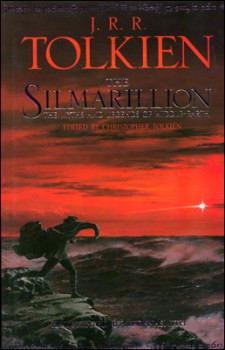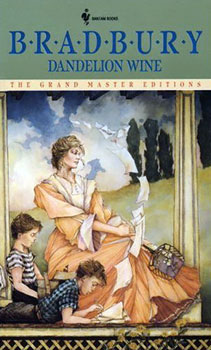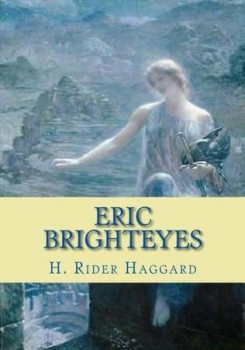My top five reads of 2010
 For my final post of 2010 I thought I would revisit something from my days as a writer for the now-defunct Cimmerian blog: My top 5 reads of the year. Not super-original, I know, but the New Year always seems to bring out the list-maker in me.
For my final post of 2010 I thought I would revisit something from my days as a writer for the now-defunct Cimmerian blog: My top 5 reads of the year. Not super-original, I know, but the New Year always seems to bring out the list-maker in me.
Some of these books were new to me and some were old favorites that I revisited, but all are highly recommended.
The Silmarillion, J.R.R. Tolkien
As 2010 began I returned to J.R.R. Tolkien’s legendarium after a span of several years. While reading I wrote a series of blog posts about it over on The Cimmerian (they start here if you’re interested). I was excited at the prospect of revisiting Middle-Earth’s back stories and foundational myths and hoped that The Silmarillion would reward a return voyage.
As it turned out, The First (and Second, and Third) Ages of Middle-Earth as told in The Silmarillion were even better than I suspected or hoped they would be. From the Dagor Brallogach to the Nirnaeth Arnoediad, from The Fall of Gondolin to the Voyage of Eärendil, how could they be otherwise? There are few things so moving to me as Hurin’s last stand at The Battle of Unnumbered Tears, which encapsulates so much that I love about fantasy literature: great feats of arms against overwhelming odds, and defiance — nay, naked rage — matched against the dying of the light:
Last of all Hurin stood alone. Then he cast aside his shield, and seized the axe of an orc-captain and wielded it two-handed; and it is sung that the axe smoked in the black blood of the troll-guard of Gothmog until it withered, and each time that he slew Hurin cried aloud: ‘Aure entuluva! Day shall come again!’ Seventy times he uttered that cry; but they took him at last alive, by the command of Morgoth, who thought thus to do him more evil than by death. Therefore the Orcs grappled Hurin with their hands, which clung to him still, though he hewed off their arms; and ever their numbers were renewed, till he fell buried beneath them.
The Silmarillion might not be for everyone, but I found it awesome, inspiring, and brilliant. Telephone directory in Elvish my ass (okay, that particular description always makes me smile). It provides rare, exotic glimpses of a rich and wonderful secondary world of which I have yet to find an equal. Everything in The Lord of the Rings is its echo. While it may not be as grounded, as accessible, nor ultimately as successful as a work of literature as The Lord of the Rings, The Silmarillion is my opinion just as great. For it is myth writ large.
 Dandelion Wine, Ray Bradbury
Dandelion Wine, Ray Bradbury
This was my first time reading Bradbury’s semi-autobiographical novel about a boy’s coming of age (or rather, his becoming) at age 12 in the summer of 1928. On the first morning of that magical summer Douglas Spaulding realizes that he’s alive. Consequently, he realizes that he will also die one day. The rest of the book is an episodic journey through the summer, with Bradbury switching the focus between Spaulding and a cast of other memorable characters in Green Town, Illinois. Green Town is a pseudonym for Bradbury’s real home of Waukeagan, IL, where one summer as a boy of 12 he made the decision to become a writer.
Bradbury’s books aren’t really about plot as much as they are about places and people and things. I recall an interview with Bradbury in which he described beginning his stories using a process of word-association. He would think of a word or series of words and build a story from that. This technique plays out wonderfully in Dandelion Wine, whose wonderful images become burned into your memory as if you lived them yourself. Though it’s been several months since I’ve read it, the Old Arcade with its coin-operated gypsy fortune teller, the Ravine, and Mr. Jones’ Traveling Junk Wagon are still etched into my memory. I almost feel like they were part of my own youth.
One of Dandelion Wine’s central themes is that the world needs magic. When we try to classify and explain and categorize too much, the magic is drained away. Human beings operate in the realms of faith and mystery, not just cold, clinical materialism. Bradbury manages to capture this sentiment in Dandelion Wine and bottle it up in a great little novel.
Deliverance, James Dickey
I read fantasy for the action, the adventure, the storytelling, and the sense of palpable danger that real life typically doesn’t provide (thank goodness). But when the swords-and-sorcery well runs dry I find that realistic adventure fiction and non-fiction scratches the same itch. That’s why I find works like The Call of the Wild and The Sea Wolf by Jack London, Alive by Piers Paul Read, and Into Thin Air by Jon Krakauer so enjoyable: They satisfy the same primal needs as the stories of an Edgar Rice Burroughs or David Gemmell. The best modern adventure fiction/non-fiction stories are bedfellows with heroic fiction: While they may not contain magic or monstrous beasts, they allow us to experience savagery and survival in the wild and vicariously walk the line of life and death.
My favorite work in this “wilderness survival” genre is Deliverance by James Dickey, which I re-read this year. I’ve found that most people know the film, but very few have read the book, which is a damned shame. The movie is actually quite good but (as is almost always the case) the book is better, with better characterization, more poetry, and a bit more philosophizing about man’s place in the wilderness. Go into the woods deep enough, get into it deep enough, and law and civilization melt away, even here on earth, in these times. Just like a Barsoom or Melniboné, the deep woods of Dickey’s Deliverance take us to places and situations we’d never want to confront in our own lives, but can savor vicariously in the pages of a book.
 Eric Brighteyes, H. Rider Haggard.
Eric Brighteyes, H. Rider Haggard.
Although the number of novels set during the Viking Age is relatively low compared to those employing a backdrop of a faux Middle-Ages, I have generally found them to be of exceeding high quality. Poul Anderson’s Hrolf Kraki’s Saga and The Broken Sword are great, as is Bernard Cornwell’s historic fiction series The Saxon Stories, but ranking right up with them and perhaps even higher in this Norse pantheon of books is H. Rider Haggard’s Eric Brighteyes.
The spirit of the Icelandic Sagas infuses every page of Haggard’s novel. The action takes place in Iceland, a hard, stony country of hard snows and unforgiving seas. Men either make their fortunes off the land, by trading on the open seas, or by the taking of plunder in coastal raids (often all three). From the bones of this hardy soil is sprung Eric Brighteyes. Eric is the archetype of the Nordic hero: Blond, handsome, fearless, and mighty in arms and feats of strength. Yet for all his strength he too is subject to the same forces of fate that rule all men. Tragedy is woven into its fiber and the Norns stand ready, shears in hand. Written in 1890, Eric Brighteyes is the kind of fantasy novel we need more of today: Powerful, well-written, standalone, the stuff of adventure and dark magic that, at its core, grapples with the human condition, featuring heroes and heroines that match their love and loyalty and bravery against the implacable dark.
Return of the Sorcerer, Clark Ashton Smith.
I confessed on the Black Gate website back in July (my very first post here on BG, by the way) that, save for the occasional short story I encountered in the odd anthology, I was largely a Clark Ashton Smith virgin. This was no small source of shame, given that CAS is viewed as one of the Big Three, a trio of the greatest pulp horror/fantasy writers of all time that includes H.P. Lovecraft and Robert E. Howard. So I was thrilled when Prime Books in 2009 issued The Return of the Sorcerer: The Best of Clark Ashton Smith, a nice selection of 18 stories that includes tales like “The City of Singing Flame,” “The Double Shadow” and “The Isle of the Torturers.” Gene Wolfe provides the introduction.
I now understand what everyone else was talking about, all these years. I returned from the pages of Sorcerer a changed man. I have trekked on distant planets, seen alien beings beyond my conception, and peered wide-eyed over the shoulders of reckless sorcerers reading from musty tomes of lore that should not be opened. I have witnessed wonders and horrors beyond the knowledge of mankind. It was a wonderful experience. Though they comprise only a small part of his body of work, the stories of The Return of the Sorcerer reveal Smith as a man of staggering imagination, considerable poetic skill, and surprising literary depth.
Splendid post, Brian. And that scene from The Silmarillion has stayed with me since I read it three decades ago… an enormously powerful piece of writing.
I’m relieved to hear that you found the book even more compelling after a fresh reading… I admit I haven’t returned to it in all these years, out of many of the same fears you had.
Maybe Im strange, but I preferred the Silmarillion (well the parts set in the First Age and Before) to the Lord of the Rings…
And I also reread it this year, while listening to the podcast of the “Tolkien Professor”‘s spring class.
Thanks John. The Silmarillion is definitely worth revisiting. There’s nothing quite like it in fantasy literature.
TW: I have heard a few die-hard Tolkien fans make the same claim. While The Silmarillion isn’t as coherent or fleshed-out as The Lord of the Rings, the stories it holds are equally if not more powerful and moving. And the scope of it is 100x the size. There are battles in there that make the Pellennor Fields look like a skirmish, for example, and Morgoth is Sauron amplified by a factor of ten.
I haven’t listened to all of the Tolkien professors’ stuff, but what I have heard I’ve enjoyed immensely.
What is up with the determination to read The Silmarillion in 2010? I also repurchased the book and gave it a shot last year. I bogged down in the First Age, made it to the Second Age and stopped… Two tries, two failures, although I did get a copy of Tolkien’s Unfinished Tales which is much the same format and loved it… strange, but I will agree the combat is something! I think the thing I enjoy most about Tokien’s work is the agelessness of the Elves and how that makes the world drip with depth.
Scott: I hear ya. Over the Summer I reread The Hobbit, but just couldn’t make it through The Silmarillian. But hey, there’s always the new year!
I think the low number of novels inspired by Nordic myths and sagas is, in one sense, a good thing. They have generally remained true to the spirit of the source material, unlike, for instance, many of the awful books claiming to be derived from Celtic myths.
The Silmarillion is a brilliant piece of literature. The book can be difficult to read straight through for some but I’ve found it rewarding to go back and re-read individual chapters or tales. The Children of Hurin, of course, should also be read more than once.
Welcome to the ranks of the acolytes of Klarkash-Ton! Nightshade books has done fantasy a great service over the past few years by getting all of Smith’s weird fiction back into print in 5 beautiful volumes. I was tempted to get The Return of the Sorceror just to read Wolfe’s intro. The Arkham House “best of,” A Rendevous in Averoigne, is a very fine selection, and with 30 stories, more comprehensive than the Prime Books volume.
I, too, will proudly claim to love THE SILMARILLION even better than LORD OF THE RINGS. I recognize that it’s not as accessible to “mainstream” readers as LOTR (which isn’t exactly accessible in the first place). SILMARILLION is definitely one of the all-time great fantasies.
Glad you discovered more Clark Ashton Smith…without a doubt one of the world’s greatest fantasists of any generation.